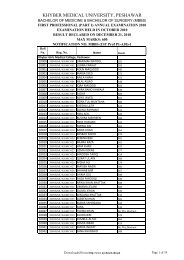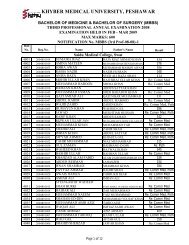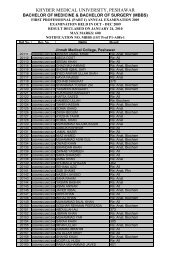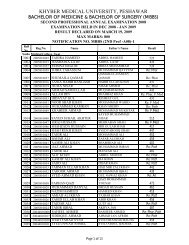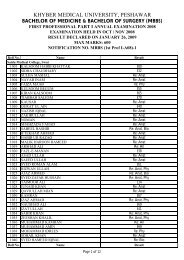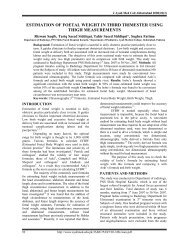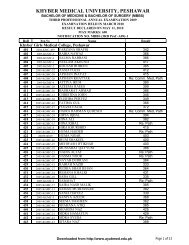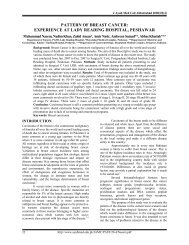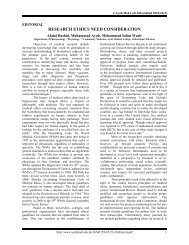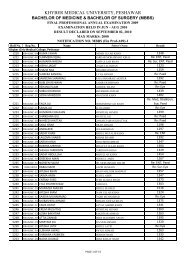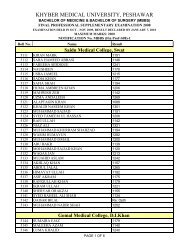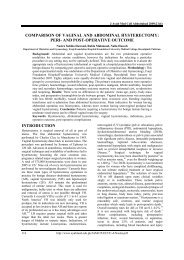evaluation techniques in punjab, pakistan - Ayub Medical College
evaluation techniques in punjab, pakistan - Ayub Medical College
evaluation techniques in punjab, pakistan - Ayub Medical College
You also want an ePaper? Increase the reach of your titles
YUMPU automatically turns print PDFs into web optimized ePapers that Google loves.
J <strong>Ayub</strong> Med Coll Abbottabad 2011;23(1)<br />
MEDICAL EDUCATION<br />
EVALUATION TECHNIQUES IN PUNJAB, PAKISTAN: EIGHT YEARS<br />
OF REFORMS IN HEALTH PROFESSIONAL EDUCATION<br />
Junaid Sarfraz Khan, John SG Biggs*, Malik Hussa<strong>in</strong> Mubbashar**<br />
Controller of Exam<strong>in</strong>ations, Department of Exam<strong>in</strong>ations, University of Health Sciences, Lahore, *Adjunct Professor of <strong>Medical</strong><br />
Education, University of Health Sciences, Lahore, **Vice Chancellor, University of Health sciences, Lahore, Pakistan<br />
Pakistan, the most populated country <strong>in</strong> the WHO Eastern Mediterranean region has a population<br />
of over 170 million, spread over five prov<strong>in</strong>ces and four federally adm<strong>in</strong>istered areas. It has a<br />
growth rate of 1.9%. Punjab is the most populous and developed prov<strong>in</strong>ce with an estimated<br />
population <strong>in</strong> 2010 of 81 million. In 2008, Punjab’s development <strong>in</strong>dex of 0.60 and a literacy rate<br />
of 80% were the highest <strong>in</strong> the country. In Pakistan, the number of doctors and nurses has risen<br />
from 48 to 71 per 100,000 and from 16 to 30 per 100,000, respectively between 1990 and 2003.<br />
The major challenge, still, is the imbalance of the population to health-care workers ratio. At the<br />
time of creation of Pakistan, K<strong>in</strong>g Edward <strong>Medical</strong> <strong>College</strong> was the only fully function<strong>in</strong>g medical<br />
college. Over the years, as a result of health reform <strong>in</strong>itiatives, a number of government medical<br />
colleges were established <strong>in</strong> the country. University of Health Sciences, Lahore was established <strong>in</strong><br />
2002, hav<strong>in</strong>g sole jurisdiction over all medical, dental and allied health <strong>in</strong>stitutes <strong>in</strong> the prov<strong>in</strong>ce<br />
with the aim of mov<strong>in</strong>g medical education towards an outcome-based patient and communityoriented<br />
competency-driven system. This paper attempts to clarify how <strong>in</strong>itiatives and reforms <strong>in</strong><br />
the <strong>evaluation</strong> process have helped the UHS realise its aims. Evaluation <strong>in</strong> all branches of higher<br />
education has long been taken as a means to an end. The focus of UHS on teacher-tra<strong>in</strong><strong>in</strong>g,<br />
<strong>in</strong>troduction of behavioural sciences as a compulsory subject and sett<strong>in</strong>g up an outcome-based<br />
<strong>evaluation</strong> process, has established a knowledge-acquisition medical education atmosphere. The<br />
challenges <strong>in</strong> the future relate to susta<strong>in</strong>ability through capacity-build<strong>in</strong>g and stay<strong>in</strong>g abreast with<br />
the Best Evidence <strong>Medical</strong> Education practices worldwide, implement<strong>in</strong>g them to fit our local<br />
needs and resources.<br />
Keywords: Evaluation, Exam<strong>in</strong>ation, Education, Punjab, OSCE, OSPE<br />
INTRODUCTION<br />
Pakistan is the most populated country <strong>in</strong> the WHO<br />
Eastern Mediterranean region with a population of over<br />
170 million, spread over five prov<strong>in</strong>ces (Punjab, S<strong>in</strong>dh,<br />
Khyber Pakhtunkhawa, Baluchistan, and Gilgit and<br />
Baltistan) and 7 Agencies and 6 Regions of Federally<br />
Adm<strong>in</strong>istered Tribal Areas, with a growth rate of 1.9%. 1<br />
The average literacy rate is 55%. 2 In 2009,<br />
Gross Domestic Product (GDP) per capita of Pakistan<br />
was US$ 841. 3 Socioeconomic development is low with<br />
high levels of poverty. Recently, government efforts to<br />
scale up development were h<strong>in</strong>dered by an earthquake<br />
measur<strong>in</strong>g 7.6 on the Richter scale which struck the<br />
north and north west of the country <strong>in</strong> October 2005 4 ,<br />
and countrywide floods <strong>in</strong> the summer of 2010. Both<br />
events resulted <strong>in</strong> around 30 million <strong>in</strong> dire need of<br />
health services.<br />
Punjab is the most populous and developed<br />
prov<strong>in</strong>ce of Pakistan with an estimated population <strong>in</strong><br />
2010 of 81 million. 5,6 Punjab is bordered by Indian<br />
Kashmir to the north, India to the east, Pakistani<br />
prov<strong>in</strong>ces of S<strong>in</strong>dh to the south, Baluchistan to the<br />
south-west, Khyber Pakhtunkhawa to the west, and<br />
Islamabad capital territory to the north. Of all the<br />
prov<strong>in</strong>ces, its development <strong>in</strong>dex at 0.60 and the literacy<br />
rate at 80% were the highest, <strong>in</strong> 2008. 7,8<br />
Challenges <strong>in</strong> the Health-Care Delivery:<br />
In Pakistan, the number of doctors and nurses has risen<br />
from 48 to 71 per 100,000 and from 16–30 per 100,000,<br />
respectively between 1990 and 2003. 3 The major<br />
challenge, still, is the imbalance of the population to<br />
health-care workers ratio.<br />
In 2009, neonatal mortality rate of 42, <strong>in</strong>fant<br />
mortality rate of 71, under-5 mortality rate of 87 and a<br />
maternal mortality ratio of 260 were amongst the<br />
highest <strong>in</strong> the world. Crude birth and death rates were<br />
reported <strong>in</strong> 2009 at 7 and 30 respectively. 9<br />
A list of health expenditure <strong>in</strong>dicators are<br />
provided <strong>in</strong> Table-1, while the human and physical<br />
resources <strong>in</strong>dicators rate (R) per 10,000 population is<br />
presented <strong>in</strong> Table-2.<br />
Table-1: Health expenditure <strong>in</strong>dicators 3<br />
Health <strong>in</strong>dicators Expenditure Year<br />
Total expenditure on health (per capita) 24 2008<br />
Average US$ exchange rate<br />
Government expenditure on health (per 7 2008<br />
capita) Average US$ exchange rate<br />
Total expenditure on health of % of GDP 2.9 2008<br />
General government expenditure on<br />
29.7 2008<br />
health as % of total health expenditure<br />
Out-of-pocket expenditure as % of total<br />
health expenditure<br />
57.9 2008<br />
154<br />
http://www.ayubmed.edu.pk/JAMC/23-1/Junaid.pdf
J <strong>Ayub</strong> Med Coll Abbottabad 2011;23(1)<br />
Table-2: Human and physical resources <strong>in</strong>dicators<br />
Rate (R) per 10,000 population 3<br />
Resources Rate/10,000 Year<br />
Physicians 8.0 2009<br />
Dentists 1.0 2009<br />
Pharmacists 0.9 2009<br />
Nurs<strong>in</strong>g and midwifery 6.0 2009<br />
Hospital beds 6.0 2009<br />
Infrastructure - primary health care 1.0 2009<br />
units and centres<br />
At the time of creation of Pakistan, <strong>in</strong> August<br />
1947, when the population was 72 million, K<strong>in</strong>g<br />
Edward <strong>Medical</strong> <strong>College</strong> was the only medical college<br />
<strong>in</strong> both west and east w<strong>in</strong>gs of the country. <strong>College</strong>s <strong>in</strong><br />
Karachi and Dhaka opened <strong>in</strong> 1951. In the first decade,<br />
the country faced an acute shortage of registered<br />
medical practitioners from 500 to 1,000 due to mass<br />
migrations at the time of Independence. 10<br />
Fac<strong>in</strong>g the challenges:<br />
As a result of health reform <strong>in</strong>itiatives, a number of<br />
government medical colleges were established.<br />
Pakistan <strong>Medical</strong> and Dental Council was<br />
established <strong>in</strong> 1962 as the sole licens<strong>in</strong>g and registration<br />
authority for doctors and dentists, and a regulat<strong>in</strong>g<br />
authority for the medical education <strong>in</strong> the country. 11<br />
Through approval from PMDC, the first private medical<br />
college was established <strong>in</strong> 1995. S<strong>in</strong>ce then, the<br />
prov<strong>in</strong>ce of Punjab has seen a rapid growth of private<br />
medical education. A list of public and private medical,<br />
dental and allied health <strong>in</strong>stitutions <strong>in</strong> Punjab is shown<br />
<strong>in</strong> Table-3. 12,13<br />
Patchwork of <strong>Medical</strong> Education <strong>in</strong> Pakistan:<br />
<strong>Medical</strong> education <strong>in</strong> Pakistan follows the<br />
British system. 10 This import<strong>in</strong>g and graft<strong>in</strong>g process of<br />
western curricula, teach<strong>in</strong>g methods and assessment<br />
<strong>techniques</strong> <strong>in</strong> our own medical education system has<br />
cont<strong>in</strong>ued s<strong>in</strong>ce <strong>in</strong>dependence. The result was a<br />
patchwork of medical education. S<strong>in</strong>ce no real efforts<br />
were made for standardis<strong>in</strong>g medical education, the<br />
medical education system was based on outdated<br />
curricula and <strong>evaluation</strong> procedures. Basic medical,<br />
nurs<strong>in</strong>g and life health sciences were neglected. 14<br />
Research culture was almost non-existent and there<br />
were no means of capacity build<strong>in</strong>g, professional<br />
development or audit of health professionals. The result<br />
was a deterioration of health-care delivery and Pakistani<br />
health-care professional qualifications were not<br />
recognized <strong>in</strong>ternationally.<br />
A dedicated Public Sector Health Sciences<br />
University <strong>in</strong> Punjab:<br />
It was aga<strong>in</strong>st this backdrop that the need for a separate<br />
and dedicated medical university was felt, and<br />
University of Health Sciences (UHS), Lahore, came <strong>in</strong>to<br />
existence on September 28 th , 2002, the first of its k<strong>in</strong>d <strong>in</strong><br />
the prov<strong>in</strong>ce of Punjab. 15<br />
Table-3: Public and Private <strong>Medical</strong>, Dental, and<br />
Allied Health Institutes <strong>in</strong> Punjab<br />
Name of <strong>Medical</strong> and Dental <strong>College</strong>s<br />
Established<br />
Government <strong>Medical</strong> and Dental <strong>College</strong>s <strong>in</strong> Punjab<br />
K<strong>in</strong>g Edward <strong>Medical</strong> <strong>College</strong>, Lahore 1860<br />
de’ Montmorency <strong>College</strong> of Dentistry, Lahore 1934<br />
Fatima J<strong>in</strong>nah <strong>Medical</strong> <strong>College</strong> for Women, Lahore 1948<br />
Nishtar <strong>Medical</strong> <strong>College</strong>, Multan 1951<br />
Quaid-e-Azam <strong>Medical</strong> <strong>College</strong>, Bahawalpur 1971<br />
Punjab <strong>Medical</strong> <strong>College</strong>, Faisalabad 1973<br />
Nishter Institute of Dentistry, Multan 1974<br />
Rawalp<strong>in</strong>di <strong>Medical</strong> <strong>College</strong>, Rawalp<strong>in</strong>di 1974<br />
Allama Iqbal <strong>Medical</strong> <strong>College</strong>, Lahore 1975<br />
Army <strong>Medical</strong> <strong>College</strong>, Rawalp<strong>in</strong>di 1977<br />
Sheikh Khalifa B<strong>in</strong> Zayed Al Nayhan <strong>Medical</strong> <strong>College</strong>, 1986<br />
Lahore<br />
Services Institute of <strong>Medical</strong> Sciences, Lahore 2003<br />
Shaikh Zayed <strong>Medical</strong> <strong>College</strong>, R.Y. Khan 2003<br />
Sargodha <strong>Medical</strong> <strong>College</strong>, Sargodha 2006<br />
Nawaz Sharif <strong>Medical</strong> <strong>College</strong>, University of Gujrat 2008<br />
Private <strong>Medical</strong> and Dental <strong>College</strong>s <strong>in</strong> Punjab<br />
Islamic International <strong>Medical</strong> <strong>College</strong>, Rawalp<strong>in</strong>di 1995<br />
Lahore <strong>Medical</strong> & Dental <strong>College</strong>, Lahore. 1998<br />
Margalla Institute of Heath Sciences, Rawalp<strong>in</strong>di 1997<br />
University <strong>College</strong> of Medic<strong>in</strong>e & Dentistry, Lahore 1999<br />
Shifa <strong>College</strong> of Medic<strong>in</strong>e, Islamabad 1999<br />
FMH <strong>College</strong> of Medic<strong>in</strong>e & Dentistry, Lahore 2000<br />
Foundation University <strong>Medical</strong> <strong>College</strong>, Rawalp<strong>in</strong>di 2000<br />
Islamabad <strong>Medical</strong> & Dental <strong>College</strong>, Islamabad 2000<br />
Independent <strong>Medical</strong> <strong>College</strong>, Faisalabad 2000<br />
Wah <strong>Medical</strong> <strong>College</strong>, Wah Cantt 2002<br />
University <strong>Medical</strong> <strong>College</strong>, Faisalabad 2003<br />
CMH Lahore <strong>Medical</strong> <strong>College</strong>, Lahore 2006<br />
Sharif <strong>Medical</strong> & Dental <strong>College</strong>, Lahore 2007<br />
Cont<strong>in</strong>ental <strong>Medical</strong> <strong>College</strong>, Lahore 2007<br />
Akhtar Saeed <strong>Medical</strong> & Dental <strong>College</strong>, Lahore 2008<br />
Central Parks <strong>Medical</strong> <strong>College</strong>, Lahore 2008<br />
Multan <strong>Medical</strong> & Dental <strong>College</strong>, Multan 2008<br />
Shalamar <strong>Medical</strong> and Dental <strong>College</strong>, Lahore 2009<br />
Yusra <strong>Medical</strong> & Dental <strong>College</strong>, Rawalp<strong>in</strong>di 2009<br />
Rashid Latif <strong>Medical</strong> <strong>College</strong>, Lahore 2010<br />
Avicenna <strong>Medical</strong> <strong>College</strong>, Lahore 2010<br />
Am<strong>in</strong>a Inayat <strong>Medical</strong> <strong>College</strong>, Sheikhupura 2010<br />
Islam <strong>Medical</strong> <strong>College</strong>, Sialkot 2010<br />
Public and Private Allied Health Institutes <strong>in</strong> Punjab<br />
Institute of Public Health, Lahore 1949<br />
Armed Forces Postgraduate <strong>Medical</strong> Institute, Rawalp<strong>in</strong>di 1952<br />
Armed Forces Institute of Pathology, Rawalp<strong>in</strong>di 1957<br />
Postgraduate <strong>Medical</strong> Institute, Lahore 1974<br />
<strong>College</strong> of Nurs<strong>in</strong>g, Shalamar Hospital, Lahore 1982<br />
Pakistan Institute of ophthalmology, Al-Shifa Eye Trust 1985<br />
Hospital, Rawalp<strong>in</strong>di<br />
Punjab Institute of Cardiology, Lahore 1988<br />
School of Allied Health Sciences, The Children’s 1990<br />
Hospital & Institute of Child Health, Lahore<br />
Saida Waheed FMH <strong>College</strong> of Nurs<strong>in</strong>g, Lahore 1999<br />
ACE Institute of Health Sciences, Lahore 1999<br />
Sughhra Shafi <strong>Medical</strong> Complex, Narowal 2003<br />
Gulab Devi Postgraduate <strong>Medical</strong> Institute, Lahore 2004<br />
Faisalabad Institute of Research Sciences & Technology, 2005<br />
Faisalabad<br />
Field Epidemiology & Laboratory Tra<strong>in</strong><strong>in</strong>g Program, 2006<br />
Pakistan<br />
Munawar Memorial Hospital, Chakwal (Institute of 2009<br />
Optometry)<br />
http://www.ayubmed.edu.pk/JAMC/23-1/Junaid.pdf 155
J <strong>Ayub</strong> Med Coll Abbottabad 2011;23(1)<br />
The mission of the University is to promote<br />
the delivery of a bio-psycho-social model of health-care.<br />
It aims to establish preventive, therapeutic and<br />
rehabilitative doma<strong>in</strong>s of health-care delivery. The<br />
University has the charter of affiliat<strong>in</strong>g all public and<br />
private medical, dental and Allied Health Sciences<br />
<strong>in</strong>stitutions with<strong>in</strong> the Prov<strong>in</strong>ce of Punjab (Table-3). It<br />
was ideally suited to br<strong>in</strong>g about a revolution through<br />
evolution <strong>in</strong> the medical education environment of the<br />
prov<strong>in</strong>ce.<br />
The University has been pivotal <strong>in</strong> <strong>in</strong>troduc<strong>in</strong>g<br />
an outcome-based 16 , student and patient-centered 17,18 ,<br />
community-oriented and problem-based curricula and<br />
<strong>evaluation</strong> <strong>techniques</strong> 19,20 , rooted <strong>in</strong> local needs and<br />
demands.<br />
Evaluation drives education:<br />
The exam<strong>in</strong>ation system evaluates the students and,<br />
through a process of analysis of result and audit,<br />
exam<strong>in</strong>es the curriculum, the teach<strong>in</strong>g methodology,<br />
and the <strong>techniques</strong> and strategies used to assess and<br />
evaluate the knowledge 21,22,23 and competency of the<br />
students 24,25 (Figure-1).<br />
Figure-1: The Education Cycle<br />
<strong>Medical</strong> education is largely outcome-cantered<br />
and the exam<strong>in</strong><strong>in</strong>g system should focus on evaluat<strong>in</strong>g<br />
the ‘higher mental function’ and ‘reason<strong>in</strong>g skills’,<br />
preferably <strong>in</strong> the sett<strong>in</strong>gs they are most likely to be<br />
used. 26 The results reflect on the teachers and the<br />
teach<strong>in</strong>g methods as much as it does on the students and<br />
their competency.<br />
The <strong>evaluation</strong> system plays a role of<br />
regulat<strong>in</strong>g the education cycle, s<strong>in</strong>ce it determ<strong>in</strong>es the<br />
product of the system and manages and <strong>in</strong>forms of<br />
changes <strong>in</strong> the curricular content and teach<strong>in</strong>g<br />
methodology. It is required to have sufficient breadth<br />
and depth to be able to engage the student <strong>in</strong> evaluat<strong>in</strong>g<br />
their competency and knowledge of the curricular<br />
content. It is, therefore, usual for higher education<br />
programmes to base their tra<strong>in</strong><strong>in</strong>g and teach<strong>in</strong>g methods<br />
on the outcomes, contrary to the didactic method of<br />
bas<strong>in</strong>g the outcomes on curricular content.<br />
Without a fair, just and outcome-based<br />
exam<strong>in</strong>ation system 27 , the validity and authenticity of an<br />
educational programme will rema<strong>in</strong> questionable. In<br />
today’s global environment, it is the exam<strong>in</strong>ation system<br />
that provides worldwide standardisation to the products<br />
of medical schools.<br />
Reforms <strong>in</strong> Evaluation <strong>in</strong> <strong>Medical</strong> Education:<br />
The changes <strong>in</strong> the assessment <strong>techniques</strong> have been<br />
<strong>in</strong>creas<strong>in</strong>gly task and problem oriented. This applies to<br />
outcome-based assessment us<strong>in</strong>g Structured Answer<br />
Questions (SAQs), Multiple Choice Questions (MCQs)<br />
and Objective Structured Cl<strong>in</strong>ical Exam<strong>in</strong>ation (OSCE),<br />
that test the higher order and reason<strong>in</strong>g skills of<br />
students. 28,29 This has directed students to problem and<br />
task-based learn<strong>in</strong>g strategies.<br />
The University realised that a change <strong>in</strong> the<br />
medical education environment would only be last<strong>in</strong>g<br />
and effective if brought about through chang<strong>in</strong>g the<br />
exam<strong>in</strong>ation system. UHS has restructured the system,<br />
from essay type exam<strong>in</strong>ations, subjective mark<strong>in</strong>g and<br />
other <strong>in</strong>tensive tests, <strong>in</strong>to objective type questions<br />
(MCQs & SAQs), an assessment key for mark<strong>in</strong>g, and<br />
concept-<strong>in</strong>tensive exam<strong>in</strong>ation. Excerpts from the<br />
visitors book are reproduced below:<br />
“……very impressive system with excellent<br />
transparency arrangements. Congratulations.”<br />
(Prof. Stuart Montgomery, Imperial <strong>College</strong>, School of Medic<strong>in</strong>e,<br />
London. December 09, 2003).<br />
“……very impressed with the concept of sett<strong>in</strong>g state-ofthe-art<br />
standards <strong>in</strong> medical education and <strong>evaluation</strong>.<br />
Outstand<strong>in</strong>g evidence of an <strong>in</strong>telligent approach. Best<br />
wishes for your future, development and success.”<br />
(Prof. Charles Sorbie, Past President of International Society of<br />
Orthopedic Surgery and Traumatolgoy & Professor of Surgery,<br />
Queen’s University, K<strong>in</strong>gshire, Canada. January 20, 2004).<br />
“……we hope your dream has come true, as we see<br />
today on our visit such an impressive setup, a dire need<br />
for quality assurance <strong>in</strong> medical education.”<br />
(Dr. Meena Nathan Cherian, <strong>Medical</strong> Officer, WHO, Geneva,<br />
Switzerland. January 20, 2004).<br />
“……very impressive and unique system which I wish to<br />
see <strong>in</strong> other countries of the Islamic World.<br />
Congratulations.”<br />
(Prof. Gamal I. Serour, Al-Azhar University, Cairo, Egypt. December<br />
17, 2003).<br />
A Brief Overview of the UHS Evaluation Process:<br />
The University of Health Sciences conducts 292<br />
Undergraduate and Postgraduate Exam<strong>in</strong>ations per<br />
year for 19, 200 candidates.<br />
Undergraduate & Postgraduate exam<strong>in</strong>ations calendar<br />
approved by the respective Board of Studies is<br />
notified a year <strong>in</strong> advance.<br />
From the approved list, subject specialists are <strong>in</strong>vited<br />
up to 6 months before the commencement of<br />
exam<strong>in</strong>ations to develop a bank of Multiple Choice<br />
Questions, Structured Answer Questions and Static<br />
156<br />
http://www.ayubmed.edu.pk/JAMC/23-1/Junaid.pdf
J <strong>Ayub</strong> Med Coll Abbottabad 2011;23(1)<br />
and <strong>in</strong>teractive stations of Objective Structured<br />
Performance Evaluation (OSPE), and to review<br />
exist<strong>in</strong>g ones.<br />
The Question Bank together with a reference key (to<br />
be used for assessment when required) is developed<br />
centrally at UHS by senior subject specialists.<br />
The f<strong>in</strong>al paper is set us<strong>in</strong>g the UHS Question Bank<br />
and the International Database for Enhanced<br />
Assessment and Learn<strong>in</strong>g 30 <strong>in</strong> accordance with the<br />
syllabus and Tables of Specifications follow<strong>in</strong>g<br />
Bloom’s Taxonomy 31 .<br />
Strict criteria, <strong>in</strong>clud<strong>in</strong>g attendance & cont<strong>in</strong>uous<br />
assessment results, are applied to eligibility to sit <strong>in</strong><br />
all exam<strong>in</strong>ations.<br />
The f<strong>in</strong>al paper set has at least 90% problem-based,<br />
patient-oriented questions. For assessment of<br />
psychometric and affective doma<strong>in</strong>s, students’ have a<br />
viva voce and cl<strong>in</strong>ical, competency-based, patientoriented<br />
OSCE conducted by a team of senior subject<br />
specialists. In the case of MCQs, multiple coded<br />
copies of the same paper are produced, shuffl<strong>in</strong>g the<br />
sequence of questions and responses with<strong>in</strong> to<br />
discourage the use of unfair means.<br />
All question papers are bar-coded and the students are<br />
required to enter their names, bar-code No. and<br />
shuffl<strong>in</strong>g code of the question paper for record<br />
keep<strong>in</strong>g at the time of exam<strong>in</strong>ations.<br />
All exam<strong>in</strong>ation-related material is sent to specially<br />
designed, secure, triplicate key lockers at over 20<br />
centres throughout Punjab under secure transport,<br />
packed <strong>in</strong> specially designed waterproof and<br />
confidential envelopes.<br />
The question paper envelopes are opened only after<br />
the students have identified themselves us<strong>in</strong>g the<br />
UHS issued photo-identity cards, and have been<br />
seated <strong>in</strong> centres throughout Punjab.<br />
Specially tra<strong>in</strong>ed supervisory staff at all centres add to<br />
the efficiency of the exam<strong>in</strong>ation and prevent any use<br />
of unfair means.<br />
Used and unused exam<strong>in</strong>ations material, from<br />
throughout Punjab, is returned on the same day under<br />
secure transport to the Exam<strong>in</strong>ations Department of<br />
UHS <strong>in</strong> sealed bundles.<br />
All returned exam<strong>in</strong>ation material is tallied with the<br />
list of bar-codes and ledger numbers of the material<br />
sent to exam<strong>in</strong>ation centres to prevent use of unfair<br />
means and leakage from the Questions Bank.<br />
In each exam<strong>in</strong>ation, a list of fictitious roll numbers is<br />
generated aga<strong>in</strong>st the orig<strong>in</strong>al roll numbers of<br />
candidates and the fictitious roll numbers are applied<br />
to all exam<strong>in</strong>ation-related material of candidates. This<br />
confidential fictitious list is deposited <strong>in</strong> a secure<br />
locker of the Vice Chancellor of UHS, Lahore. Thus,<br />
the result of candidates is prepared under fictitious<br />
cover.<br />
Centralised assessment is undertaken us<strong>in</strong>g the<br />
standardised reference key for assessment.<br />
One assessor marks only one question of all<br />
candidates.<br />
A separate team of Subject Specialists randomly<br />
reviews the scripts assessed to ensure quality control<br />
and any discrepancies are rectified at this po<strong>in</strong>t.<br />
Multiple Choice Questions are assessed us<strong>in</strong>g an<br />
Optical Mark Reader (OMR).<br />
Questions <strong>in</strong> which 90% of the candidates have failed<br />
are culled from assessment.<br />
10% of all MCQ response forms are checked<br />
manually for quality control.<br />
For any unfair means case registered, the decision of<br />
an Independent Discipl<strong>in</strong>ary Committee is f<strong>in</strong>al.<br />
A comprehensive result is prepared enter<strong>in</strong>g the<br />
awards of all components and subcomponents of<br />
assessment <strong>in</strong>clud<strong>in</strong>g all SAQs, MCQs, all OSPE<br />
stations, viva voce, all cl<strong>in</strong>ical and practical stations<br />
and <strong>in</strong>ternal assessment <strong>in</strong> a custom-made software<br />
us<strong>in</strong>g fictitious students’ numbers.<br />
The scripts of students fail<strong>in</strong>g by up to 3 marks are<br />
reviewed by a team of subject specialists for quality<br />
control prior to declaration of result.<br />
Duplicate result is prepared under fictitious cover at<br />
both Secrecy and Tabulation Sections and tallied<br />
(master checked) to ensure that there are no mistakes.<br />
The key of fictitious cover is retrieved from the locker<br />
of the Vice Chancellor and result declared with<strong>in</strong> half<br />
an hour.<br />
Candidates may apply for recheck<strong>in</strong>g of totall<strong>in</strong>g of<br />
awards with<strong>in</strong> 10 days after the date of result.<br />
(However, mistakes are extremely rare 1:100,000)<br />
CONCLUSIONS<br />
Evaluation <strong>in</strong> all branches of higher education has<br />
long been taken as a means to an end. Success <strong>in</strong><br />
higher education, especially medical education <strong>in</strong><br />
Pakistan, is a ticket to a better future, nationally or<br />
abroad. However, many students study to get through<br />
the end-of-year exam<strong>in</strong>ations and not for the<br />
acquisition of knowledge and competency.<br />
Innovations <strong>in</strong> curricula and teach<strong>in</strong>g methodologies<br />
<strong>in</strong>troduced by the UHS <strong>in</strong> Punjab have reformed the<br />
medical education environment. Its focus on teachertra<strong>in</strong><strong>in</strong>g,<br />
<strong>in</strong>troduction of behavioural sciences as a<br />
compulsory subject and sett<strong>in</strong>g up an outcome-based<br />
<strong>evaluation</strong> process, has established a knowledgeacquisition<br />
medical education atmosphere.<br />
The challenges <strong>in</strong> the future relate to<br />
susta<strong>in</strong>ability through capacity-build<strong>in</strong>g and stay<strong>in</strong>g<br />
abreast with the Best Evidence <strong>Medical</strong> Education<br />
(BEME) practices worldwide, implement<strong>in</strong>g them to<br />
fit our local needs and resources.<br />
http://www.ayubmed.edu.pk/JAMC/23-1/Junaid.pdf 157
J <strong>Ayub</strong> Med Coll Abbottabad 2011;23(1)<br />
REFERENCES<br />
1. WHO [homepage on the <strong>in</strong>ternet]. Cairo; 2005-2009 [cited 2011<br />
March 02]. Country Cooperation Strategy for WHO and<br />
Pakistan; [About 33 screens]. URL: http://www.who.<strong>in</strong>t/<br />
countryfocus/cooperation_strategy/ccs_pak_en.pdf<br />
2. Farooq U. M<strong>in</strong>istry of F<strong>in</strong>ance. Economic Survey 2009-10;<br />
Pakistan Economic Survey 2009–10, Chapter 12, pp. 145–59<br />
[serial on the Internet]. [Cited 2011 March 04]. Available from:<br />
http://f<strong>in</strong>ance.gov.pk/survey/chapter_10/ 10_Education.pdf<br />
3. WHO Country profiles [homepage on the <strong>in</strong>ternet]. Regional<br />
office for the Eastern Mediterranean; [cited 2011 March 03].<br />
Available from: http://www.emro.who.<strong>in</strong>t/emr<strong>in</strong>fo/<br />
<strong>in</strong>dex.aspx?Ctry=pak<br />
4. WHO [homepage on the <strong>in</strong>ternet]. Cairo; 2006 [cited 2011<br />
March 05] Country Cooperation Strategy: at a glance, [About 2<br />
screens], available from: http://www.who.<strong>in</strong>t/countryfocus/<br />
cooperation_strategy/ccsbrief_pak_en.pdf<br />
5. Punjab Gateway; Government of the Punjab. [homepage on the<br />
Internet]. Punjab. [cited 2011 March 03]. Available from:<br />
http://pportal.<strong>punjab</strong>.gov.pk/portal/portal/media-type/html/user/<br />
anon/page/default.psml/js_panename/ContentViewAdm<strong>in</strong>/portal/<br />
306/nav/right/<strong>punjab</strong>cms/servlet/PunjabCMSServlet?CMDCMS<br />
=V_D_BROWSER&CMDDOCTYPE=1&txtDocID=7394&txt<br />
VersionID=1.<br />
6. World gazetteer; Punjab. 2010 [cited 2011 March 03]. Available<br />
from: http://www.worldgazetteer.com/wg.php?x=&men=gpro&lng<br />
=en&des=wg&geo=-2943&srt=pnan&col=abcdefgh<strong>in</strong>oq&<br />
msz=1500<br />
7. Statistics Division, Government of Pakistan. Labour Force<br />
Survey, 2007-2008 [homepage on Internet]. D.P. Center<br />
Islamabad. [cited 2011 March 03]. Available form:<br />
http://www.statpak.gov.pk/depts/fbs/publications/lfs2007_08/res<br />
ults.pdf<br />
8. Haider M. S<strong>in</strong>dh-Balochistan Lowest & most neglected<br />
<strong>in</strong> Pakistan; IAOJ [Serial on the Internet]. 2010 October;<br />
Available from: http://iaoj.wordpress.com/2010/06/02/s<strong>in</strong>dhbalochistan-lowest-most-neglected-<strong>in</strong>-<strong>pakistan</strong>/<br />
9. Unicef Pakistan Statistics [homepage on the Internet]. 2009 [cited<br />
2011 March 04]. available from: www.unicef.org/<strong>in</strong>fobycountry/<br />
<strong>pakistan</strong>-<strong>pakistan</strong>statistics.html.<br />
10. Afridi MK. <strong>Medical</strong> Education <strong>in</strong> Pakistan. J Med Edu<br />
1962;37:962–70.<br />
11. Pakistan <strong>Medical</strong> & Dental Council. About Us [homepage on the<br />
<strong>in</strong>ternet]. Plexus Pvt. Available from: http://www.pmdc.org.pk/<br />
AboutUs/tabid/72/Default.aspx<br />
12. PFMSG. Recommended Teach<strong>in</strong>g Hospitals [homepage on the<br />
Internet]. Pakistan: 2008. URL: http://www.pfmsg.com/<br />
teach<strong>in</strong>ghosp.htm<br />
13. University of Health Sciences, Lahore, Dental and Allied Health<br />
Institutes[homepage on the Internet]. Available from:<br />
http://www.uhs.edu.pk/registration/aff<strong>in</strong>st.html<br />
14. Kazi A. Expired Medic<strong>in</strong>e: <strong>Medical</strong> Education <strong>in</strong> Pakistan<br />
[homepage on the Internet]. Newsl<strong>in</strong>e ; [2004 June] Available<br />
from: www.newsl<strong>in</strong>emagaz<strong>in</strong>e.com/2010/06/expired-medic<strong>in</strong>emedical-education-<strong>in</strong>-<strong>pakistan</strong>/<br />
15. Government of the Punjab; Law and Parliamentary Affairs<br />
Department, Notification 2002 September, 28 th (The Punjab<br />
Gazette); Ord<strong>in</strong>ance 2002, University of Health Sciences,<br />
Lahore.<br />
16. Mukhopadhyay S, Smith S. Outcomes-based education:<br />
pr<strong>in</strong>ciples and practice, J Obstet Gynaecol 2010;30:790–4.<br />
17. Frankel RM, Edd<strong>in</strong>s-Folensbee F, Inui TS. Cross<strong>in</strong>g the patient-<br />
Centered Divide: Transform<strong>in</strong>g Health Care Quality Through<br />
Enhanced Faculty Development. Acd Med 2011;86:445–52.<br />
18. Emanuel L, Walton M, Hatlie M, Lau D, Shaw T, Shalowitz J, et<br />
al. The Patient Safety Education Project: An International<br />
Collaboration. In: Henriksen K, Battles JB, Keyes MA, Grady<br />
ML, editors. Advances <strong>in</strong> Patient Safety: New Directions and<br />
Alternative Approaches (Vol. 2: Culture and Redesign).<br />
Rockville (MD): Agency for Healthcare Research and Quality<br />
(US); 2008.<br />
19. Brennan N, Corrigan O, Allard J, Barnes R, Bleakley A, Collett<br />
T, de-Bere SR. The transition from medical student to junior<br />
doctor: today’s experiences of Tomorrow’s Doctors. Med Edu<br />
2010;44:449–8.<br />
20. Sales CS, Schlaff AL. Reform<strong>in</strong>g medical education: a review<br />
and synthesis of five critiques of medical practice. Soc Sci Med<br />
2010;70:1665–8.<br />
21. Abid K, Qureshi AL, Yasm<strong>in</strong> R. Cont<strong>in</strong>uum of medical<br />
education: objectively <strong>in</strong> <strong>in</strong>structional method, learn<strong>in</strong>g and<br />
assessment. J Pak Med Assoc 2010;60(4):262–4.<br />
22. Kim KJ, Kee C. Reform of medical education <strong>in</strong> Korea. Med<br />
Teach 2010;32(2):113–7.<br />
23. Heise B, Himes D, The course council: an example of studentcentered<br />
learn<strong>in</strong>g. J Nurs Edu 2010;49:343–5.<br />
24. Masiello I. Why simulation-based team tra<strong>in</strong><strong>in</strong>g has not been<br />
used effectively and what can be done about it. Adv Health Sci<br />
Educ Theory Pract 2012;17(2):279–88. Epub 2011 Feb 11.<br />
25. Hendricson WD, Rugh JD, Hatch JP, Stark DL, Deahl T,<br />
Wallmann ER. Validation of an <strong>in</strong>strument to assess, and<br />
confidence <strong>in</strong> the dental environment. J Dent Educ<br />
2011;75(2):131–44.<br />
26. Potomkova J, Mihal V, Zapletalova J, Subova D. Integration of<br />
evidence-based practice <strong>in</strong> beside teach<strong>in</strong>g paediatrics supported<br />
by e-learn<strong>in</strong>g. Biomed Pap Med Fac Univ Palacky Olomouc<br />
Czech Repub 2010;154(1):83–7.<br />
27. Mcneil HP, Hughes CS, Toohey SM, & Dowton SBr. An<br />
<strong>in</strong>novative outcomes-based medical education program built on<br />
adult learn<strong>in</strong>g pr<strong>in</strong>ciples. Med Teach. 2006; 28(6): 527-534.<br />
28. Sousa AC, Wagner DP, Henry RC, Mavis BE. Better data for<br />
teachers, better data for learners, better patient care: college-wide<br />
assessment at Michigan State University’s <strong>College</strong> of Human<br />
Medic<strong>in</strong>e. Med Edu Onl<strong>in</strong>e [serial on Internet]. 2011 Jan 14;<br />
[cited 2011 March 7]; 16 doi: 10.3402/meo.v16i0.5926.<br />
Available from:<br />
http://www.ncbi.nlm.nih.gov/pubmed/21249172<br />
29. Price DW, Miller EK, Raham AK, Brace NE, Larson RS.<br />
Assessment of barriers to chang<strong>in</strong>g practice as CME outcomes. J<br />
Cont<strong>in</strong> Educ Health Prof 2010;30(4):237–45.<br />
30. IDEAL Consortium, Quality Enhancement Cell; University of<br />
Health Sciences, Lahore, Pakistan. Available from:<br />
www.uhs.edu.pk/qec/<strong>in</strong>dicators.html<br />
31. L<strong>in</strong>n RL, Gronlund NE. Measurement and Assessment <strong>in</strong><br />
Teach<strong>in</strong>g, 9 th ed. India: Parson Education Inc; 2005. p. 526–7.<br />
Address for Correspondence:<br />
Dr. Junaid Sarfraz Khan, Controller of Exam<strong>in</strong>ations and Professor of <strong>Medical</strong> Education, University of Health Sciences,<br />
Khayaban-e-Jamia Punjab, Lahore, Pakistan. Tel: +92-42-99231218; Fax: +92-42-99231857<br />
Email: junaidsarfraz@hotmail.com<br />
158<br />
http://www.ayubmed.edu.pk/JAMC/23-1/Junaid.pdf



